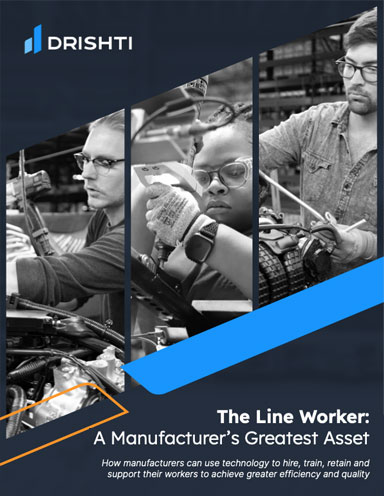Manufacturers large and small have been affected by shortages of skilled labor. How can robotics and artificial intelligence help businesses get the most out of their workers, while creating a satisfying work environment?
Manufacturers should invest not only in people, but also in the systems and technology that empowers workers and enables the business to adapt to changing market conditions. “Investing in technology that will aid workers in doing their jobs more effectively is the best way to stay competitive in the manufacturing world,” said Prasad Akella, founder and chairman of Drishti.
Check out this eBook to learn how to position your organization to attract and retain talent. You can also find out about best practices for employee training, the appropriate role of innovation, and how Drishti’s technology can help. Best of all, Drishti spoke with 500 entry-level employees to get their perspectives on factory jobs and what they want out of a career.
Manufacturers should start with people
The COVID-19 pandemic accelerated pressures on manufacturing and supply chain operations. At the same time, fewer people are aware of long-term career prospects in those sectors, leading to a shortage of 2.1 million skilled jobs by 2030, according to Deloitte. Fortunately, factories are no longer full of dull, dirty, and dangerous tasks, thanks to robotics and automation. In addition, some manufacturers are working with educational institutions to provide pathways to a new generation of workers. To get the most out of their employees, companies must consider job satisfaction, privacy, safety, and continuous growth, notes Drishti. New technologies can help.
Drishti addresses the future of manufacturing
Drishti has created technology that analyzes production video to provide previously unavailable data on manual processes. Drishti helps manufacturers analyze and apply this data for continuous improvement.
With this data, manufacturers can better understand production bottlenecks, play to worker’s strengths, and improve assembly processes and productivity with both people and machines.
After all, quality and productivity improvements are contingent on the worker.
“Within a few minutes of viewing the video footage from Drishti, our team had ideas to reconfigure the station to make it more comfortable for the line associates, and shortening every cycle time,” said Ram Singh Khangarote, operational excellence and product manager at HELLA Dhankot. “And most importantly, our line associates are healthier, happier and more productive.”
Check out this eBook from Drishti, which discusses how manufacturers can get the most out of both their employees and technologies such as AI. It also examines ways to improve retention and competitiveness.
Sponsored by Drishti
Article topics
Email Sign Up












